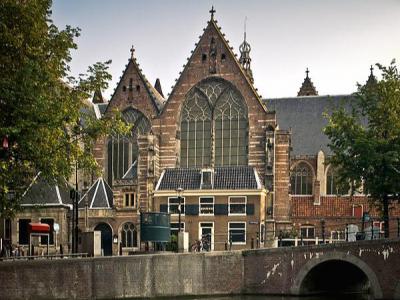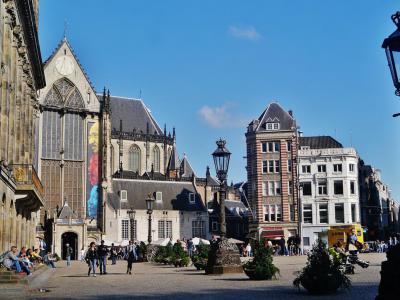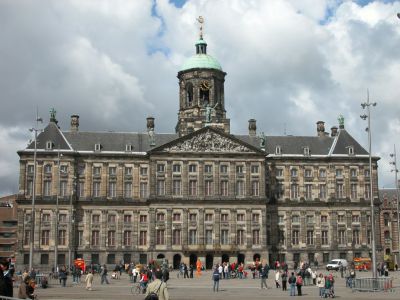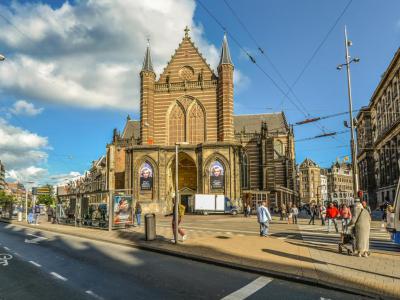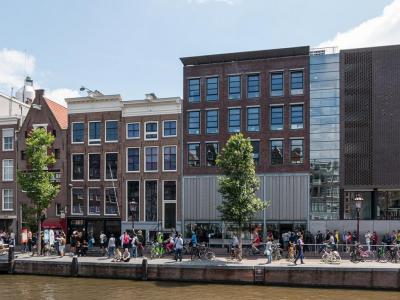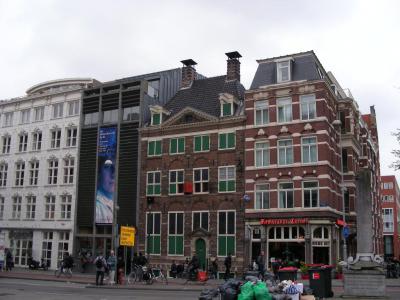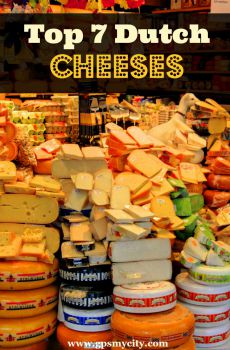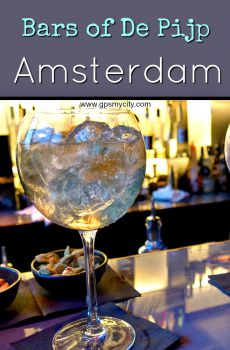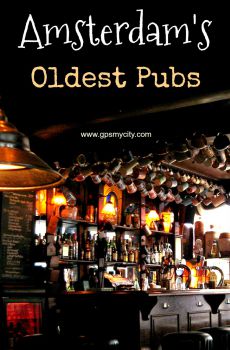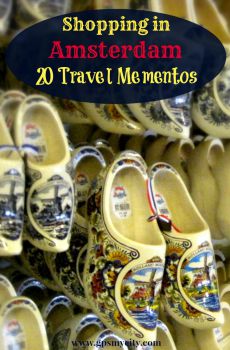
Amsterdam Introduction Walking Tour (Self Guided), Amsterdam
The Dutch capital, Amsterdam, some say, “dances to its own beat.” Indeed, Amsterdam – where “hipness meets history” – has a rather unusual life rhythm and style, famously manifested in the air of legalized cannabis, coffee shops, and the Red Light District. In large part, this “air of freedom” attracts annually to the city over five million visitors.
As a small fishing village, Amsterdam emerged in the late 1270s around a dam on the river Amstel and was known initially as “Amstelredamme”. Today, Dam Square is the historical core of the city. Dominating it is the grandiose Royal Palace. Originally built as the town hall, it was later transformed into the royal residence by King Louis Bonaparte.
During the Dutch Golden Age, in the 17th century, Amsterdam became a major international port and financial and commercial center. Trading in spices, diamonds, textiles, and most notably tulips, made Amsterdam enormously rich. It was here that "tulips bloomed and dreams came alive." Today, the Tulip Museum of Amsterdam offers a deep dive into the history of the Netherlands' most celebrated flower.
Other legacies of that era include great artistic heritage associated with renowned painters like Rembrandt and Vermeer and the elaborate canal system for which Amsterdam is colloquially referred to as the "Venice of the North". In the 19th and 20th centuries, the city significantly expanded, adapting to modern infrastructure. An impressive showcase of the Dutch Neo-Renaissance architectural grandeur is the Central (railway) Station, completed in 1889.
Amsterdam's nightlife and festive mood are also an attraction in its own right.
For a sobering glimpse into the city's history, one can explore the Anne Frank House outlining the experiences of a courageous Jewish girl during WWII and the atrocities of the Holocaust.
In Amsterdam, every street seems like a work of art, where narrow gabled houses whisper stories of the past. To hear them loud and experience Amsterdam's magic firsthand, you may need a knowledgeable guide. Some say that losing yourself in Amsterdam is the best way to find yourself. If that's true, this GPSmyCity self-guided tour of Amsterdam is a good way to lose yourself without getting lost.
As a small fishing village, Amsterdam emerged in the late 1270s around a dam on the river Amstel and was known initially as “Amstelredamme”. Today, Dam Square is the historical core of the city. Dominating it is the grandiose Royal Palace. Originally built as the town hall, it was later transformed into the royal residence by King Louis Bonaparte.
During the Dutch Golden Age, in the 17th century, Amsterdam became a major international port and financial and commercial center. Trading in spices, diamonds, textiles, and most notably tulips, made Amsterdam enormously rich. It was here that "tulips bloomed and dreams came alive." Today, the Tulip Museum of Amsterdam offers a deep dive into the history of the Netherlands' most celebrated flower.
Other legacies of that era include great artistic heritage associated with renowned painters like Rembrandt and Vermeer and the elaborate canal system for which Amsterdam is colloquially referred to as the "Venice of the North". In the 19th and 20th centuries, the city significantly expanded, adapting to modern infrastructure. An impressive showcase of the Dutch Neo-Renaissance architectural grandeur is the Central (railway) Station, completed in 1889.
Amsterdam's nightlife and festive mood are also an attraction in its own right.
For a sobering glimpse into the city's history, one can explore the Anne Frank House outlining the experiences of a courageous Jewish girl during WWII and the atrocities of the Holocaust.
In Amsterdam, every street seems like a work of art, where narrow gabled houses whisper stories of the past. To hear them loud and experience Amsterdam's magic firsthand, you may need a knowledgeable guide. Some say that losing yourself in Amsterdam is the best way to find yourself. If that's true, this GPSmyCity self-guided tour of Amsterdam is a good way to lose yourself without getting lost.
How it works: Download the app "GPSmyCity: Walks in 1K+ Cities" from Apple App Store or Google Play Store to your mobile phone or tablet. The app turns your mobile device into a personal tour guide and its built-in GPS navigation functions guide you from one tour stop to next. The app works offline, so no data plan is needed when traveling abroad.
Amsterdam Introduction Walking Tour Map
Guide Name: Amsterdam Introduction Walking Tour
Guide Location: Netherlands » Amsterdam (See other walking tours in Amsterdam)
Guide Type: Self-guided Walking Tour (Sightseeing)
# of Attractions: 10
Tour Duration: 2 Hour(s)
Travel Distance: 4.0 Km or 2.5 Miles
Author: kane
Sight(s) Featured in This Guide:
Guide Location: Netherlands » Amsterdam (See other walking tours in Amsterdam)
Guide Type: Self-guided Walking Tour (Sightseeing)
# of Attractions: 10
Tour Duration: 2 Hour(s)
Travel Distance: 4.0 Km or 2.5 Miles
Author: kane
Sight(s) Featured in This Guide:
- Centraal Station
- Oude Kerk (Old Church)
- Dam Square
- Koninklijk Paleis (Royal Palace of Amsterdam)
- Nieuwe Kerk (New Church)
- Magna Plaza
- Tulip Museum
- Anne Frank House
- Kalverstraat (Calf Street)
- Museum Het Rembrandthuis (Rembrandt House Museum)
1) Centraal Station (must see)
When in Amsterdam, a visit to the Central Station is practically inevitable. Nearly every traveler to the city encounters it at least once.
Amsterdam Centraal is the largest railway station in the city and has the second longest railway platform in the country, with a length of 695 meters, and a cast-iron platform roof spanning approximately 40 meters. A major international railway hub, it is used daily by almost 200,000 passengers, making it the Netherlands' most visited national heritage object.
Amsterdam Centraal was designed by Dutch architect Pierre Cuypers, featuring a blend of Gothic and Renaissance Revival elements.
The station was constructed on three artificial islands, between 1882 and 1889. Controversially located at the city's waterfront, it took a precise total of 8,687 wooden piles to anchor such a monumental structure on the marshy ground. The station spurred significant urban redevelopment and shifted Amsterdam’s focus from a waterfront to an inland city, influencing both transportation and city planning.
Its design celebrates Dutch economic and colonial prowess through various decorative elements. Initially, the entire project seemed like a huge blunder and was swiftly criticized by numerous experts. However, the architects persevered and ultimately vindicated themselves, defying skeptics.
Through the decades, Amsterdam Centraal has undergone multiple renovations and expansions to meet modern demands. Significant developments included the creation of a pedestrian tunnel in the 1950s, expansion of metro facilities in the late 1970s, and a major overhaul in the 1980s and 1990s that introduced new signaling systems, expanded tracks, and additional roofing. Recent upgrades focus on enhancing capacity and accessibility, including extended platforms for international trains, a new bus station, and upgraded retail spaces, marking it as a central hub in Amsterdam’s urban landscape.
Tip:
Take advantage of the several free ferry trips navigating the canals, departing every 5 to 15 minutes from this location; they offer a rewarding experience. You can even cruise back to the station via boat if you wish, rounding out your visit with a picturesque waterborne journey.
Amsterdam Centraal is the largest railway station in the city and has the second longest railway platform in the country, with a length of 695 meters, and a cast-iron platform roof spanning approximately 40 meters. A major international railway hub, it is used daily by almost 200,000 passengers, making it the Netherlands' most visited national heritage object.
Amsterdam Centraal was designed by Dutch architect Pierre Cuypers, featuring a blend of Gothic and Renaissance Revival elements.
The station was constructed on three artificial islands, between 1882 and 1889. Controversially located at the city's waterfront, it took a precise total of 8,687 wooden piles to anchor such a monumental structure on the marshy ground. The station spurred significant urban redevelopment and shifted Amsterdam’s focus from a waterfront to an inland city, influencing both transportation and city planning.
Its design celebrates Dutch economic and colonial prowess through various decorative elements. Initially, the entire project seemed like a huge blunder and was swiftly criticized by numerous experts. However, the architects persevered and ultimately vindicated themselves, defying skeptics.
Through the decades, Amsterdam Centraal has undergone multiple renovations and expansions to meet modern demands. Significant developments included the creation of a pedestrian tunnel in the 1950s, expansion of metro facilities in the late 1970s, and a major overhaul in the 1980s and 1990s that introduced new signaling systems, expanded tracks, and additional roofing. Recent upgrades focus on enhancing capacity and accessibility, including extended platforms for international trains, a new bus station, and upgraded retail spaces, marking it as a central hub in Amsterdam’s urban landscape.
Tip:
Take advantage of the several free ferry trips navigating the canals, departing every 5 to 15 minutes from this location; they offer a rewarding experience. You can even cruise back to the station via boat if you wish, rounding out your visit with a picturesque waterborne journey.
2) Oude Kerk (Old Church)
Amsterdam’s oldest building, the Old Church, boasts the largest medieval wooden vault in Europe. The initial wooden chapel on this site was built around 1213. Eventually replaced by a stone structure, in 1306, the church was dedicated to Saint Nicolas. To ensure its stability in a marshy area, the foundations were set on an artificial mound.
Throughout the centuries, the church has undergone numerous transformations. The most significant, in the 15th century, included the addition of north and south transepts, forming a cross shape, and the expansion of the aisles prompted by the necessity to recover from the destruction caused by fires in the early 1400s. Originally Roman Catholic, the church transitioned to its present Calvinist denomination in 1578, after the Dutch Revolt against Spanish rule. This transition led to the Iconoclastic Fury, with rioters destroying much of the church's art.
The Old Church boasts significant artistic and personal histories. It has ties to Rembrandt, who was a frequent visitor here for his children’s christenings. Today, this connection is honored by the annual celebration of Rembrandt’s wife, Saskia, who is buried inside. Each spring, on March 9, her tomb is illuminated by a unique play of sunlight in the morning.
The entire floor of the church is covered in gravestones. This is because it's built over a cemetery. Locals continued to be buried here until 1865. There are in total 2,500 graves, holding the remains of some 10,000 parishioners. Among them are the famed organist and composer Jan Pieterszoon Sweelinck; the revered naval hero Jacob van Heemskerck; and Frans Banning Cocq, the central character in Rembrandt's painting "The Night Watch".
Also, the interior – surprisingly spacious – contains a collection of exquisite stained glass, rare ceiling frescoes, and four pipe organs, including the renowned Vater-Müller organ built in 1724 and recognized as one of the finest Baroque organs in Europe.
As of 2012, the Old Church has been home to an art institute, the newest in town, featuring specific installations and a permanent exhibit on the history of Amsterdam.
Each year in mid-March, Catholics arrive at the Old Church to celebrate the so-called "Miracle of Amsterdam" which occurred in 1345. Legend has it that after taking communion, a dying man vomited the Sacramental bread – known as the Host – which is used in the Christian ritual of the Eucharist. When the bread was thrown into a fire, as prescribed by the tradition, it did not burn and was proclaimed a miracle. The Host was then put in a chest and displayed at the church. However, it disappeared during the Reformation period.
Tip:
Wonderful views from the tower (note the fee payable with credit/debit cards only); coffee and snacks are available in a charming garden.
Throughout the centuries, the church has undergone numerous transformations. The most significant, in the 15th century, included the addition of north and south transepts, forming a cross shape, and the expansion of the aisles prompted by the necessity to recover from the destruction caused by fires in the early 1400s. Originally Roman Catholic, the church transitioned to its present Calvinist denomination in 1578, after the Dutch Revolt against Spanish rule. This transition led to the Iconoclastic Fury, with rioters destroying much of the church's art.
The Old Church boasts significant artistic and personal histories. It has ties to Rembrandt, who was a frequent visitor here for his children’s christenings. Today, this connection is honored by the annual celebration of Rembrandt’s wife, Saskia, who is buried inside. Each spring, on March 9, her tomb is illuminated by a unique play of sunlight in the morning.
The entire floor of the church is covered in gravestones. This is because it's built over a cemetery. Locals continued to be buried here until 1865. There are in total 2,500 graves, holding the remains of some 10,000 parishioners. Among them are the famed organist and composer Jan Pieterszoon Sweelinck; the revered naval hero Jacob van Heemskerck; and Frans Banning Cocq, the central character in Rembrandt's painting "The Night Watch".
Also, the interior – surprisingly spacious – contains a collection of exquisite stained glass, rare ceiling frescoes, and four pipe organs, including the renowned Vater-Müller organ built in 1724 and recognized as one of the finest Baroque organs in Europe.
As of 2012, the Old Church has been home to an art institute, the newest in town, featuring specific installations and a permanent exhibit on the history of Amsterdam.
Each year in mid-March, Catholics arrive at the Old Church to celebrate the so-called "Miracle of Amsterdam" which occurred in 1345. Legend has it that after taking communion, a dying man vomited the Sacramental bread – known as the Host – which is used in the Christian ritual of the Eucharist. When the bread was thrown into a fire, as prescribed by the tradition, it did not burn and was proclaimed a miracle. The Host was then put in a chest and displayed at the church. However, it disappeared during the Reformation period.
Tip:
Wonderful views from the tower (note the fee payable with credit/debit cards only); coffee and snacks are available in a charming garden.
3) Dam Square (must see)
Dam Square, or the Dam, is a central town square in Amsterdam, known for its significant buildings and frequent events. Positioned in the historical heart of Amsterdam, it sits on the site of the original dam on the Amstel River. The square extends some 200 meters from west to east and 100 meters from north to south, connecting Damrak and Rokin streets that trace the Amstel's original course.
The square is also the termination point for other notable streets like New Dike, Calf Street, and Dam Street, with the main red-light district, De Wallen, just beyond its northeast corner. Prominent features on Dam Square include the neoclassical Royal Palace, the 15th-century Gothic New Church, the Madame Tussauds Wax Museum, and the National Monument which honors World War II victims, all of which collectively turn the Dam into a major tourist hub.
The name "Amsterdam" originates from a dam built on the Amstel River around 1270. This dam, integral to the city's development, included a discharge sluice and later locks to facilitate navigation and control water levels. By 1275, the settlement was significant enough to be recorded in connection with a road toll granted by the count of Holland, Floris V. Over time, the dam expanded to accommodate a town square, now known as Dam Square. Eventually, the area became a hub for commercial and governmental activities, featuring a large fish market and a town hall.
Significant changes occurred over the centuries, including the demolition of a weigh house in 1808 to clear the view for Louis Bonaparte’s Royal Palace and the infilling of Damrak Avenue in the 19th century. The square also hosted the Beurs van Zocher stock exchange until 1903. Today, the De Bijenkorf department store has been in its place since 1914. Dam Square has also been a site for national events – such as the National Memorial Day commemorations at the National Monument unveiled in 1956, and public demonstrations, – maintaining its status as a national and cultural gathering spot for the Dutch.
Tip:
For those in need of a restroom, free and well-maintained toilets are available at the De Bijenkorf shop on the 5th floor.
The square is also the termination point for other notable streets like New Dike, Calf Street, and Dam Street, with the main red-light district, De Wallen, just beyond its northeast corner. Prominent features on Dam Square include the neoclassical Royal Palace, the 15th-century Gothic New Church, the Madame Tussauds Wax Museum, and the National Monument which honors World War II victims, all of which collectively turn the Dam into a major tourist hub.
The name "Amsterdam" originates from a dam built on the Amstel River around 1270. This dam, integral to the city's development, included a discharge sluice and later locks to facilitate navigation and control water levels. By 1275, the settlement was significant enough to be recorded in connection with a road toll granted by the count of Holland, Floris V. Over time, the dam expanded to accommodate a town square, now known as Dam Square. Eventually, the area became a hub for commercial and governmental activities, featuring a large fish market and a town hall.
Significant changes occurred over the centuries, including the demolition of a weigh house in 1808 to clear the view for Louis Bonaparte’s Royal Palace and the infilling of Damrak Avenue in the 19th century. The square also hosted the Beurs van Zocher stock exchange until 1903. Today, the De Bijenkorf department store has been in its place since 1914. Dam Square has also been a site for national events – such as the National Memorial Day commemorations at the National Monument unveiled in 1956, and public demonstrations, – maintaining its status as a national and cultural gathering spot for the Dutch.
Tip:
For those in need of a restroom, free and well-maintained toilets are available at the De Bijenkorf shop on the 5th floor.
4) Koninklijk Paleis (Royal Palace of Amsterdam) (must see)
The Royal Palace of Amsterdam is a historic monument on Dam Square and is one of the four palaces in the Netherlands still left at the disposal of the Dutch Royal Family.
Its inception dates back to 1655. Back then, the city had recently thwarted William of Orange's attempts to subdue it and the city council sought a residence that would symbolize Amsterdam's municipal authority and pride. This led to a remarkably forward-thinking design—the Dutch interpretation of the classical principles revived during the Italian Renaissance. The architectural project led by Jacob van Campen implied over 13,500 wooden piles to support the building.
Initially designed as the town hall overlooking the bustling Damrak wharves, it was converted into a royal palace by King Louis I of Holland, brother of Napoleon Bonaparte, in 1806.
In 1936, the building was designated a property of the Kingdom of the Netherlands. Today, it serves a ceremonial role for the monarchy, hosting state visits, official functions, and award ceremonies. The palace also played a pivotal role during the investiture of Queen Beatrix in 1980.
The building's distinctive sandstone façade has darkened over time. Astride the rear of it is a 6-meter statue of Atlas carrying the globe.
The interior is equally opulent, notably in the Citizens' Hall, featuring an arcaded marble chamber where the enthroned figure of Amsterdam presides over the earthly and celestial realms. Three circular, inlaid marble maps, depicting the eastern and western hemispheres, as well as the northern sky, lie at her feet. Other allegorical figures include Wisdom and Strength, flanking "Amsterdam" on her left and right, while the reliefs on either side of the central group portray the principles of good governance. On the left, the god Amphion plays his lyre, persuading stones to form a wall; and on the right, Mercury seeks to lull Argos to sleep, thus emphasizing the importance of vigilance.
Tip:
Before your visit, be sure to check online for opening hours, as the palace may occasionally be closed due to royal events.
Free entry for those under 18 and discounts for seniors and students are available.
Its inception dates back to 1655. Back then, the city had recently thwarted William of Orange's attempts to subdue it and the city council sought a residence that would symbolize Amsterdam's municipal authority and pride. This led to a remarkably forward-thinking design—the Dutch interpretation of the classical principles revived during the Italian Renaissance. The architectural project led by Jacob van Campen implied over 13,500 wooden piles to support the building.
Initially designed as the town hall overlooking the bustling Damrak wharves, it was converted into a royal palace by King Louis I of Holland, brother of Napoleon Bonaparte, in 1806.
In 1936, the building was designated a property of the Kingdom of the Netherlands. Today, it serves a ceremonial role for the monarchy, hosting state visits, official functions, and award ceremonies. The palace also played a pivotal role during the investiture of Queen Beatrix in 1980.
The building's distinctive sandstone façade has darkened over time. Astride the rear of it is a 6-meter statue of Atlas carrying the globe.
The interior is equally opulent, notably in the Citizens' Hall, featuring an arcaded marble chamber where the enthroned figure of Amsterdam presides over the earthly and celestial realms. Three circular, inlaid marble maps, depicting the eastern and western hemispheres, as well as the northern sky, lie at her feet. Other allegorical figures include Wisdom and Strength, flanking "Amsterdam" on her left and right, while the reliefs on either side of the central group portray the principles of good governance. On the left, the god Amphion plays his lyre, persuading stones to form a wall; and on the right, Mercury seeks to lull Argos to sleep, thus emphasizing the importance of vigilance.
Tip:
Before your visit, be sure to check online for opening hours, as the palace may occasionally be closed due to royal events.
Free entry for those under 18 and discounts for seniors and students are available.
5) Nieuwe Kerk (New Church)
The New Church, a historical gem on Amsterdam's Dam Square, dates back to the 15th century. Originally serving as a Dutch Reformed Church parish, it is now part of the Protestant Church of the Netherlands.
The construction of this church in the late 14th century was prompted by a need for more religious space amid a growing population. It was completed in 1408 and consecrated a year later. Throughout the 15th century, the building suffered significant damage from fires and was nearly destroyed in 1645, which ultimately led to its Gothic-style reconstruction. Major renovations in the late 19th and mid-20th centuries introduced neo-Gothic and early-Renaissance elements.
The intricately adorned stained glass windows portray historical events associated with this church, such as Queen Wilhelmina's coronation in 1890. Notable features within the interior encompass an opulent, meticulously crafted mahogany pulpit (the result of fifteen years of painstaking effort), alongside a cunningly wrought copper chancel screen and a flamboyant Baroque organ case.
Historically significant, the New Church has hosted Dutch royal investiture ceremonies, including the most recent one of King Willem-Alexander, in 2013. It also has been the venue for royal weddings, such as Willem-Alexander's marriage to Máxima in 2002. Additionally, it serves as the final resting place for notable Dutch personalities like the naval hero Admiral Michiel de Ruyter and Joost van den Vondel, a Roman Catholic poet and playwright.
Although the church is still used for recitals, it no longer holds religious services but functions primarily as an exhibition space. The exhibitions held here cover diverse themes, including some rather unconventional ones. Attached to the church is a café accessible during opening hours and a museum store that offers a variety of related souvenirs like postcards, books, and gifts.
Tip:
Feel free to step inside the lobby to marvel at the beautiful giant stained glass panes.
Exhibitions can be a little overpriced but are good value with the I Amsterdam card.
The construction of this church in the late 14th century was prompted by a need for more religious space amid a growing population. It was completed in 1408 and consecrated a year later. Throughout the 15th century, the building suffered significant damage from fires and was nearly destroyed in 1645, which ultimately led to its Gothic-style reconstruction. Major renovations in the late 19th and mid-20th centuries introduced neo-Gothic and early-Renaissance elements.
The intricately adorned stained glass windows portray historical events associated with this church, such as Queen Wilhelmina's coronation in 1890. Notable features within the interior encompass an opulent, meticulously crafted mahogany pulpit (the result of fifteen years of painstaking effort), alongside a cunningly wrought copper chancel screen and a flamboyant Baroque organ case.
Historically significant, the New Church has hosted Dutch royal investiture ceremonies, including the most recent one of King Willem-Alexander, in 2013. It also has been the venue for royal weddings, such as Willem-Alexander's marriage to Máxima in 2002. Additionally, it serves as the final resting place for notable Dutch personalities like the naval hero Admiral Michiel de Ruyter and Joost van den Vondel, a Roman Catholic poet and playwright.
Although the church is still used for recitals, it no longer holds religious services but functions primarily as an exhibition space. The exhibitions held here cover diverse themes, including some rather unconventional ones. Attached to the church is a café accessible during opening hours and a museum store that offers a variety of related souvenirs like postcards, books, and gifts.
Tip:
Feel free to step inside the lobby to marvel at the beautiful giant stained glass panes.
Exhibitions can be a little overpriced but are good value with the I Amsterdam card.
6) Magna Plaza
Magna Plaza is a grand 19th-century edifice located behind the Royal Palace on Dam Square. Constructed between 1895 and 1899, it showcases a blend of Neo-Gothic and Neo-Renaissance architectural styles. The building was designed by Cornelis Hendrik Peters and has been listed as a national heritage site of the Netherlands since 1974.
The structure is notable for its elaborate brick exterior adorned with polychromatic brickwork and dressed stone around windows and doors. The roof is distinguished by several dormers, each topped with crow-stepped gables, contributing to its nickname "Perenburg" (or “pear-castle”) due to the pear-shaped crowns atop its towers.
Originally serving as Amsterdam's central post office, the building symbolized the city’s economic resurgence in the late 19th century, a period marked by significant developments like the opening of the North Sea Canal and the hosting of a World's Fair in 1883.
In 1987, plans to transform this historic post office into a luxurious shopping mall were announced by Larmag, a Swedish real estate developer. The renovations, which began in 1991, involved meticulous exterior restorations and a complete rebuild of the interior while preserving the structural and decorative elements. Named after Larmag's CEO, Lars-Erik Magnusson, Magna Plaza opened on August 17, 1992, as a shopping center.
Today, Magna Plaza offers a shopping experience across four floors, complemented by several cafes and a variety of stores. Despite its commercial function, the building remains an architectural gem worth visiting for its aesthetic and historical significance alone.
The structure is notable for its elaborate brick exterior adorned with polychromatic brickwork and dressed stone around windows and doors. The roof is distinguished by several dormers, each topped with crow-stepped gables, contributing to its nickname "Perenburg" (or “pear-castle”) due to the pear-shaped crowns atop its towers.
Originally serving as Amsterdam's central post office, the building symbolized the city’s economic resurgence in the late 19th century, a period marked by significant developments like the opening of the North Sea Canal and the hosting of a World's Fair in 1883.
In 1987, plans to transform this historic post office into a luxurious shopping mall were announced by Larmag, a Swedish real estate developer. The renovations, which began in 1991, involved meticulous exterior restorations and a complete rebuild of the interior while preserving the structural and decorative elements. Named after Larmag's CEO, Lars-Erik Magnusson, Magna Plaza opened on August 17, 1992, as a shopping center.
Today, Magna Plaza offers a shopping experience across four floors, complemented by several cafes and a variety of stores. Despite its commercial function, the building remains an architectural gem worth visiting for its aesthetic and historical significance alone.
7) Tulip Museum
Amsterdam Tulip Museum is a privately owned museum dedicated solely to the history of the Netherlands' most infamous flower – the tulip – and its profound impact on the nation's economy.
Tulips made their way to the Netherlands and the rest of Europe from the Ottoman Empire during the mid-16th century. This delicate bloom quickly captivated the attention of the aristocracy and was brought to Dutch soil for cultivation. The flowers soared in popularity, particularly among the elite, and became a symbol of high social standing.
The scarcer the flower's color, the more valuable its bulb was. Variations in color, petal structure, and other characteristics sent the flower's price soaring to unprecedented heights. In some cases, historical records indicate that individuals were willing to part with up to ten times their annual income for a single tulip bulb. This period, now referred to as "Tulip Mania", reached its zenith in 1637 and inflicted severe damage on the Dutch economy, earning the tulip the moniker of the "world's most dangerous flower".
The Tulip Museum – located in a canal house (just across the bridge from the Anne Frank House) – was established in 2004 by three Dutch bulbsmen. Though small in size (just 200 square meters of floor space), it is quite informative and packed to the brim with everything one needs to become a tulip addict. The collection traces the history of tulips from their origins in the Himalayas to their arrival in the court of the Ottoman Sultan Suleiman the Magnificent.
Among the exhibits, the museum features Ottoman-style Tulip-themed art and ceramics, bulb industry artifacts, and films about tulips. It also offers multimedia presentations which are viewable on LCD screens.
Tip:
The cute gift shop at the entrance is stocked with a variety of intriguing souvenirs.
Additionally, it's renowned as one of the select places offering "certified" bulbs suitable for the UK, USA, and Canada.
Also, at the nearby Cheese Museum, you can get your fill of cheese just as well!
Tulips made their way to the Netherlands and the rest of Europe from the Ottoman Empire during the mid-16th century. This delicate bloom quickly captivated the attention of the aristocracy and was brought to Dutch soil for cultivation. The flowers soared in popularity, particularly among the elite, and became a symbol of high social standing.
The scarcer the flower's color, the more valuable its bulb was. Variations in color, petal structure, and other characteristics sent the flower's price soaring to unprecedented heights. In some cases, historical records indicate that individuals were willing to part with up to ten times their annual income for a single tulip bulb. This period, now referred to as "Tulip Mania", reached its zenith in 1637 and inflicted severe damage on the Dutch economy, earning the tulip the moniker of the "world's most dangerous flower".
The Tulip Museum – located in a canal house (just across the bridge from the Anne Frank House) – was established in 2004 by three Dutch bulbsmen. Though small in size (just 200 square meters of floor space), it is quite informative and packed to the brim with everything one needs to become a tulip addict. The collection traces the history of tulips from their origins in the Himalayas to their arrival in the court of the Ottoman Sultan Suleiman the Magnificent.
Among the exhibits, the museum features Ottoman-style Tulip-themed art and ceramics, bulb industry artifacts, and films about tulips. It also offers multimedia presentations which are viewable on LCD screens.
Tip:
The cute gift shop at the entrance is stocked with a variety of intriguing souvenirs.
Additionally, it's renowned as one of the select places offering "certified" bulbs suitable for the UK, USA, and Canada.
Also, at the nearby Cheese Museum, you can get your fill of cheese just as well!
8) Anne Frank House (must see)
Anne Frank once found comfort in the gentle chimes of the Western Church’s bells—a reassuring hint of life outside her secret refuge—until those very bells were melted down for the German war effort. The church’s 85-meter-tall tower still stands as Amsterdam’s most dazzling spire. Rising gracefully above the city, it offers balconies with stunning panoramic views of the center and a carillon that strikes every quarter-hour, plus occasional full musical interludes. At its tip, you’ll find Emperor Maximilian’s crown, a proud emblem of Amsterdam and a glittering highlight of this Protestant landmark. Built by Hendrick de Keyser and completed in 1631, a decade after his passing, the church was a vital piece of the city’s early expansion.
Outwardly, the Western Church projects an air of restrained elegance; inside, however, it embraces Calvinist simplicity. Apart from the ample plain-glass windows that flood the space with natural light, the main attractions are the grand Baroque organ and the ornate wooden pulpit, topped by an oversized sounding board that once lent authority to lengthy sermons. While the Protestant elite shunned opulent decorations, they did indulge in a little exclusivity: boxed-in benches at the base of the nave’s stone columns, rented out by the well-to-do to signal their status.
Feeling adventurous? From April to October, you can climb the tower for a firsthand look at the bells and unbeatable views from a platform near the top. The stairs are steep enough to be interesting, but not so tough as to keep you from reaching one of the best vantage points in Amsterdam.
Outwardly, the Western Church projects an air of restrained elegance; inside, however, it embraces Calvinist simplicity. Apart from the ample plain-glass windows that flood the space with natural light, the main attractions are the grand Baroque organ and the ornate wooden pulpit, topped by an oversized sounding board that once lent authority to lengthy sermons. While the Protestant elite shunned opulent decorations, they did indulge in a little exclusivity: boxed-in benches at the base of the nave’s stone columns, rented out by the well-to-do to signal their status.
Feeling adventurous? From April to October, you can climb the tower for a firsthand look at the bells and unbeatable views from a platform near the top. The stairs are steep enough to be interesting, but not so tough as to keep you from reaching one of the best vantage points in Amsterdam.
9) Kalverstraat (Calf Street)
Calf Street is a pedestrian zone and a major shopping street, running for about 750 meters from Dam Square to Muntplein Square. Alongside are a number of notable locations such as the former Orphanage building (now housing the Amsterdam Museum), the Saints Peter and Paul church, and the Orphanage Gate.
The street traces its roots back to the 14th century when it was known as The Lane and served as the western dike of the Amstel River. Later, it came to be known as Calf Street after the cattle market that existed there from 1486 until 1629.
On 16 March 1345, a Eucharistic miracle (known as the Miracle of Amsterdam or the Miracle of the Host) occurred in the area. Upon receiving the Holy Sacrament and last rites, a dying man vomited The Host (or the Sacramental bread used in the Christian ritual of the Eucharist). According to liturgical regulations, The Host was then put into fire but miraculously “survived” and was retrieved from the ashes intact the following day. This miracle was quickly acknowledged and, eventually, a large pilgrim chapel, called the "Holy Site", was built on the spot where it occurred. Presently, this miracle is commemorated annually with a Silent Procession through Calf Street.
By the late 19th century, Calf Street was the first street in Amsterdam to be paved, fitted with electricity, and hosted the first public film screening by the Lumière brothers (in 1896). The V&D branch on Calf Street, opened in 1912, was the Netherlands' first real department store and the first to feature elevators and escalators.
Today, Calf Street is the most expensive shopping street in the Netherlands, with rent prices reaching up to 3,000 euros per square meter. It has approximately 150 shops including several department stores, such as Bijenkorf (Amsterdam's premier option), Peek & Cloppenburg, and Maison de Bonneterie. The five-story Kalvertoren shopping center adds about 40+ stores to the area. At Number 212, you'll encounter the ever-present and budget-friendly HEMA, established in 1926, offering affordable designer goods, practical clothing, stationery, kitchenware, and food items.
Calf Street also features a branch of the Waterstone's bookshop chain, at Number 152. On Rokin, is one of the standout shops – the PGC Hajenius tobacconist, at Number 96. If you have a penchant for Havanas from a well-maintained humidor or seek a traditional clay pipe as a souvenir, this establishment is sure to delight you.
Introduced in 1995, the Shopping Sunday regulation, allowing local shops to work on Sundays, has been drawing additional crowds to the area ever since.
The street traces its roots back to the 14th century when it was known as The Lane and served as the western dike of the Amstel River. Later, it came to be known as Calf Street after the cattle market that existed there from 1486 until 1629.
On 16 March 1345, a Eucharistic miracle (known as the Miracle of Amsterdam or the Miracle of the Host) occurred in the area. Upon receiving the Holy Sacrament and last rites, a dying man vomited The Host (or the Sacramental bread used in the Christian ritual of the Eucharist). According to liturgical regulations, The Host was then put into fire but miraculously “survived” and was retrieved from the ashes intact the following day. This miracle was quickly acknowledged and, eventually, a large pilgrim chapel, called the "Holy Site", was built on the spot where it occurred. Presently, this miracle is commemorated annually with a Silent Procession through Calf Street.
By the late 19th century, Calf Street was the first street in Amsterdam to be paved, fitted with electricity, and hosted the first public film screening by the Lumière brothers (in 1896). The V&D branch on Calf Street, opened in 1912, was the Netherlands' first real department store and the first to feature elevators and escalators.
Today, Calf Street is the most expensive shopping street in the Netherlands, with rent prices reaching up to 3,000 euros per square meter. It has approximately 150 shops including several department stores, such as Bijenkorf (Amsterdam's premier option), Peek & Cloppenburg, and Maison de Bonneterie. The five-story Kalvertoren shopping center adds about 40+ stores to the area. At Number 212, you'll encounter the ever-present and budget-friendly HEMA, established in 1926, offering affordable designer goods, practical clothing, stationery, kitchenware, and food items.
Calf Street also features a branch of the Waterstone's bookshop chain, at Number 152. On Rokin, is one of the standout shops – the PGC Hajenius tobacconist, at Number 96. If you have a penchant for Havanas from a well-maintained humidor or seek a traditional clay pipe as a souvenir, this establishment is sure to delight you.
Introduced in 1995, the Shopping Sunday regulation, allowing local shops to work on Sundays, has been drawing additional crowds to the area ever since.
10) Museum Het Rembrandthuis (Rembrandt House Museum) (must see)
This old house in Amsterdam's Jews Broadway, with an ornate facade adorned with intricate wooden shutters and an elaborate pediment, was once the home and studio of the Dutch painter Rembrandt van Rijn. Commonly known as Rembrandt, he was a prominent 17th-century figure, rightfully acclaimed as one of the foremost artists of the Dutch Golden Age—a period when the Dutch Empire enjoyed the zenith of its power and renown.
Originally built in 1606, the property served as the artist's residence during the pinnacle of his fame, a place where he resided for nearly two decades, from 1639 to 1658, and created some of his most iconic masterpieces, such as "The Night Watch."
However, the lavish expenditure on furnishings ultimately contributed to Rembrandt's financial downfall. After his bankruptcy, the house changed hands and underwent various renovations before it was purchased by Amsterdam's municipality, in 1907, and then restored and converted into a museum by 1911. The building was redesigned in the 20th century based on the inventory drawn up during Rembrandt's bankruptcy.
The museum shows Rembrandt's living and working quarters, giving the visitor an idea of the artist's daily life. Stepping inside here feels akin to entering one of Rembrandt's own paintings, with quintessential Dutch interiors featuring black-and-white tiled floors and traditional box beds. Two particularly captivating highlights include a nearly complete collection of Rembrandt's etchings, exhibited in its modern wing and etching cabinet. In Rembrandt's old house, there are also works of art by his teacher, Pieter Lastman, and his pupils, Ferdinand Bol and Govert Flinck. The museum also hosts temporary exhibitions throughout the year of the works by Rembrandt's contemporaries and (contemporary) followers.
In 2019, research confirmed that two pots found in Rembrandt’s old cesspool were used by him for mixing quartz soil, a unique canvas preparation method. These pots are now on display here.
Tip:
Reserve some time to browse the museum's quaint shop, offering a selection of delightful, high-quality souvenirs at reasonable prices. It is highly likely that you will want to get something as a keepsake for yourself too.
Originally built in 1606, the property served as the artist's residence during the pinnacle of his fame, a place where he resided for nearly two decades, from 1639 to 1658, and created some of his most iconic masterpieces, such as "The Night Watch."
However, the lavish expenditure on furnishings ultimately contributed to Rembrandt's financial downfall. After his bankruptcy, the house changed hands and underwent various renovations before it was purchased by Amsterdam's municipality, in 1907, and then restored and converted into a museum by 1911. The building was redesigned in the 20th century based on the inventory drawn up during Rembrandt's bankruptcy.
The museum shows Rembrandt's living and working quarters, giving the visitor an idea of the artist's daily life. Stepping inside here feels akin to entering one of Rembrandt's own paintings, with quintessential Dutch interiors featuring black-and-white tiled floors and traditional box beds. Two particularly captivating highlights include a nearly complete collection of Rembrandt's etchings, exhibited in its modern wing and etching cabinet. In Rembrandt's old house, there are also works of art by his teacher, Pieter Lastman, and his pupils, Ferdinand Bol and Govert Flinck. The museum also hosts temporary exhibitions throughout the year of the works by Rembrandt's contemporaries and (contemporary) followers.
In 2019, research confirmed that two pots found in Rembrandt’s old cesspool were used by him for mixing quartz soil, a unique canvas preparation method. These pots are now on display here.
Tip:
Reserve some time to browse the museum's quaint shop, offering a selection of delightful, high-quality souvenirs at reasonable prices. It is highly likely that you will want to get something as a keepsake for yourself too.
Walking Tours in Amsterdam, Netherlands
Create Your Own Walk in Amsterdam
Creating your own self-guided walk in Amsterdam is easy and fun. Choose the city attractions that you want to see and a walk route map will be created just for you. You can even set your hotel as the start point of the walk.
City Center Walking Tour
The inner-most borough and historic heart of Amsterdam, known locally as Centrum, is a tightly woven network of canals and overlapping micro-neighborhoods, each bursting with their own unique vibe and history. Formerly a working-class area, this district is reputed for its traditional community spirit, radical politics and historic brown bars.
Here, all within an easy walking distance you will... view more
Tour Duration: 2 Hour(s)
Travel Distance: 2.3 Km or 1.4 Miles
Here, all within an easy walking distance you will... view more
Tour Duration: 2 Hour(s)
Travel Distance: 2.3 Km or 1.4 Miles
Southern Canal Belt Walking Tour
The Canal District, known as Grachtengordel in Dutch, is a globally renowned example of urban planning and architectural excellence within Amsterdam. This area has remained remarkably well-preserved for over four centuries, celebrated for its charming small bridges, canal crossings, and 17th-century residences. Encircling the Old City Centre in a horseshoe shape, the Canal Ring encompasses three... view more
Tour Duration: 2 Hour(s)
Travel Distance: 3.1 Km or 1.9 Miles
Tour Duration: 2 Hour(s)
Travel Distance: 3.1 Km or 1.9 Miles
Amsterdam Food Tour
Amsterdam's food scene is a delightful fusion of local traditions and global influences. Making your way through the interlocking canals, pretty bridges, and a maze of streets laden with diverse eateries and bars may easily render you hankering for a bite to eat and/or a drink to wash it down with.
The diverse culinary landscape of Amsterdam caters to a wide range of tastes and... view more
Tour Duration: 2 Hour(s)
Travel Distance: 2.6 Km or 1.6 Miles
The diverse culinary landscape of Amsterdam caters to a wide range of tastes and... view more
Tour Duration: 2 Hour(s)
Travel Distance: 2.6 Km or 1.6 Miles
Red Light District Walking Tour
For centuries, Amsterdam’s Red Light District has been a source of endless intrigue. Its heart and the most historic section, De Wallen, is a fascinating blend of medieval charm and modern-day notoriety. Here, you’ll find timeworn canal houses leaning at curious angles, narrow cobblestone alleys lined with old bars, cozy shops, and a sprinkling of late-night establishments. And of course, the... view more
Tour Duration: 1 Hour(s)
Travel Distance: 1.8 Km or 1.1 Miles
Tour Duration: 1 Hour(s)
Travel Distance: 1.8 Km or 1.1 Miles
Amsterdam's Historical Churches Walking Tour
The history of Amsterdam is deeply intertwined with its religious heritage. The city is home to several historical churches, each with its own unique charm and significance. These religious sites serve as both spiritual centers and architectural treasures that provide insight into the city's past.
Our walk starts in the Central Station area and leads you to visit the eight most prominent... view more
Tour Duration: 2 Hour(s)
Travel Distance: 3.8 Km or 2.4 Miles
Our walk starts in the Central Station area and leads you to visit the eight most prominent... view more
Tour Duration: 2 Hour(s)
Travel Distance: 3.8 Km or 2.4 Miles
Jewish Quarter Walking Tour
Welcome to Amsterdam’s Jewish Quarter, a neighborhood rich in history, tracing the ebb and flow of the city’s Jewish community. It all began in the late 16th and early 17th centuries, when Sephardic Jews fleeing persecution in Spain and Portugal found refuge here. With its relatively tolerant atmosphere, Amsterdam quickly became a sanctuary, and before long, Ashkenazi Jews from Central and... view more
Tour Duration: 2 Hour(s)
Travel Distance: 2.3 Km or 1.4 Miles
Tour Duration: 2 Hour(s)
Travel Distance: 2.3 Km or 1.4 Miles
Useful Travel Guides for Planning Your Trip
12 Traditional Dutch Foods You Must Try in Amsterdam
Cool climate, closeness to sea, and sense of adventure have made the Dutch what they are – skillful farmers, industrious seafarers and, generally, people with the taste for life and good hearty meal, whether it comes from the sea they live by or the land they set their feet on. All of this has...
Top 7 Dutch Cheeses to Try in Amsterdam
Don't mind things turning a bit "cheesy" when in Holland. After all, this small country is renowned for its cheese manufacturing and successfully competes, in terms of cheese exports, with such economic giants as the United States and Germany. Amsterdam alone and its vicinities are...
Bars of De Pijp, Amsterdam
Sitting to the south of the Centrum (city centre) De Pijp area of Amsterdam is a fascinating mixture of trendy urbanites, students, immigrants and Amsterdammers. De Pijp has a long history as the Bohemian part of town, which is reflected in the different cafés of the area. There truly is something...
The Oldest and Historic Pubs of Amsterdam
Amsterdam is a stunningly beautiful city, steeped in history, with hidden treasures and fascinating tales practically around every corner. Like all marvelous cities, Amsterdam has its share of dining and drinking establishments from the modern to the ancient. This guide will assist you in exploring...
Dutch Sweets and Pastries
Known primarily for their cheeses, the Dutch have proven just as passionate about their sweets and pastries, many of which have come about as a result of the centuries of colonial past that had infused Holland with Oriental flavors and ingredients. Blended with their own dairy-rich European...
Souvenir Shopping in Amsterdam: 20 Dutch Things To Buy
Tulips, red lights, weed... Other than these, there are plenty of good things to remember Amsterdam by. What's more, you can take home some of them quite legally. Look here to see what to buy in Amsterdam and...
The Most Popular Cities
/ view all

